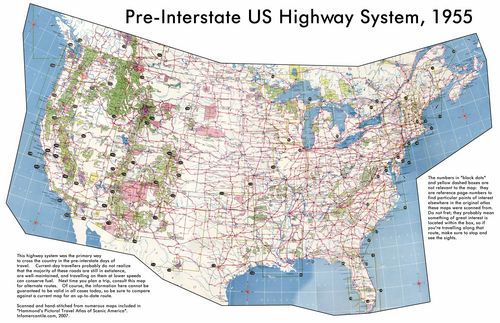Fuel Conservation On The Old Highway System
The original US highway system, a series of smaller highways assembled into a national highway system prior to the Eisenhower Interstate System, still connects the majority of large- and moderately-sized cities, with well-maintained roads, but with lower speed-limits, curves and hills, and fewer ways to pass other drivers. The lower speed limits will provide gasoline conservation, while opening up smaller communities to the travellers they lost with the Interstate, and leaving the Interstate System to industrial transporation and high-speed travel.
Contents
Introduction
My family and I travel from Fargo, North Dakota to Milwaukee and Sheboygan many times a year for family, and, of course, we've become quite familiar with the Eisenhower Interstate System. As a military man, Eisenhower served along Europe's well-developed roadways during WWII, traveled across the US' poor roads by car, and his experience followed him to his presidency. Eisenhower believed the US would benefit from a similar infrastructure, connecting our major cities with high-speed, low-access roadways to promote travel and commerce. North Dakota's stretch of I-94 was the first completed, and the system expanded from there. We drive on I-94 from Fargo, through Minneapolis, to Tomah, Wisconsin, where it connects with I-90 and continues to Milwaukee. On other occasions, when we've felt we had more time to spend, we've traveled along sections of Old US 10 in both Minnesota and Wisconsin, and we've made some discoveries that might otherwise seem counterintuitive. The slower speed limits and landscape should slow down our driving time, the hills and curves and stop-signs should severely impact fuel efficiency, and it must be difficult to find gas stations and restaurants. In fact, much of the above are untrue, and the benefits of taking a non-Interstate route outweigh the percieved benefits of the straighter, faster route.
The Non-Interstate Highway System
The US Interstate system was devised as a high-speed conduit between large cities, connecting one end of the country to the other, for transportation and commerce. The previous system of roads was hardly integrated on a national level, and large portions of interstate roads were dirt or gravel and not suitable for high speed travel. The curvy highways that connection numerous small communities were bypassed, straighter lines were drawn through far fewer communities and away from obstacles, to allow vehicles to travel with minimal reasons to change speed, stop, or watch for obstacles like pedestrians or parked cars.
Current State of Non-Interstate Highways
While many still have the mindset that non-interstate roads are of poor quality and are minimally cared for, the truth is much different. The US Department of Transportation has taken great efforts of provide a national highway system that passes within 8km of 90% of US residents[1], maintained and updated to higher standards to allow vehicles similar driving experience to the interstate, once those cards and trucks leave the interstate roads. The high fuel prices lamented by most usually come with the caveat, "well, it's all the taxes on the gas that get's you." Those taxes on the state and local levels have not evaporated; they hve gone to supporting the roads used most by the citizens who pay those fuel taxes. Stretches of rural NHS roads may have degraded surfaces, but this is no different than interstate roads to the similar regions.
Fuel Conservation at Lower Speeds
Most people my age only knew that interstate speed limits were in the 50-60mph range when we learned to drive, and over the past 15 years they've been slowly increased. In 1974, to hold back the economic destruction caused by the 1973 fuel crisis, Congress passed a national speed limit of 55mph[2], to save an estimated 17% less fuel[3] than the previous limits of around 70mph. This was not unfounded: driving slower uses less fuel, on the order of 1mpg for every 5 miles per hour over 55[4].
Personal Enjoyment
Now, this isn't just going to be an essay on saving money and the environment by driving back roads: it is, ultimately, an encouragement to return to a mindset where travelling is something enjoyed...the pocketbook savings can be seen as logical justification, if need be.
There has long been lamenting over the destruction of small cities, caused by the rerouting of transporation conduits by the Interstate system. Which this has happened, particularly in the grossly rural areas, many small towns and cities along roads in the old highway system survived, reemphasizing their services to their remaining residents, without concern about the fewer travellers passing through. Now that many of these areas are considered 'off the beaten path,' they quite often cater to tourism rather than "point-a-to-point-b" driving.
The interstate system, in its interest of speeding up transportation, has encouraged more than one generation to edvote more congruous time at the wheel, and less time relaxing. Combatting driving fatigue is often given the guideline of stopping once every two hours or 100 miles[5]; larger gas tanks, pay-at-the-pump, and that increased fuel efficiency encourage drivers to stop less often and for far less time than before.
We've taken trips on the lesser highways, and found that we didn't lose too much time stopping at a park or shop, but our spirits were much better than driving non-stop across a state. The scenery, at the very least, is enough to produce happiness and conversation.
Additional Resources
- Drive 55 Conservation Project, a blog promoting lower speed limits as a way to conserve energy and prevent global warming.
- The US Department of Transportation's National Highway System website, which provides numerous maps by state and on a national scale.
References
- ↑ The National Highway System: A Commitment to America's Future, Rodney E. Slater, Public Roads, Spring 1996
- ↑ National Maximum Speed Law, courtesy Wikipedia
- ↑ "On This Day - 15 December", BBC.co.UK
- ↑ Fuel Conservation Tips, City of Richland, Washington.
- ↑ Drowsy Driving and Fatigue, SafeNY.com
